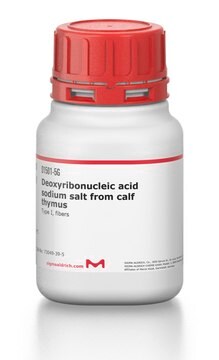D9893
pBR322 Plasmid DNA from E. coli RRI
lyophilized powder
Autenticatiper visualizzare i prezzi riservati alla tua organizzazione & contrattuali
About This Item
Numero CAS:
Numero CE:
Numero MDL:
Codice UNSPSC:
12352200
eCl@ss:
32160414
NACRES:
NA.52
Prodotti consigliati
Origine biologica
Escherichia coli
Livello qualitativo
Grado
Molecular Biology
for molecular biology
Stato
lyophilized powder
PM
2.9 MDa
4363 bp
Temperatura di conservazione
2-8°C
Cerchi prodotti simili? Visita Guida al confronto tra prodotti
Descrizione generale
Plasmid pBR322 was one of the first multipurpose cloning vectors constructed for use in E. coli. This plasmid is derived from the ColE1-type plasmid pMB1 and shares the same type of replication mechanism and controls as ColE1 and relatives. Plasmid pBR322 confers resistance to ampicillin and tetracycline. The plasmid sequence has been published.
The plasmid has unique restriction sites within the gene for ampicillin resistance (Pst I, Pvu I, and Sca I), within the gene for tetracycline resistance (BamH I, BspM I, EcoR V, Nhe I, Nru I, Sal I, Sph I, and Xma III), and elsewhere (Aat II, Ava I, Bal I, Bsm I, BspM II, Cla I, EcoR I, Hind III, Nde I, Pvu II, Ssp I, Sty I, and Tth111 I).
The plasmid has unique restriction sites within the gene for ampicillin resistance (Pst I, Pvu I, and Sca I), within the gene for tetracycline resistance (BamH I, BspM I, EcoR V, Nhe I, Nru I, Sal I, Sph I, and Xma III), and elsewhere (Aat II, Ava I, Bal I, Bsm I, BspM II, Cla I, EcoR I, Hind III, Nde I, Pvu II, Ssp I, Sty I, and Tth111 I).
Specificità
Unique Sites: Within the gene for ampicillin resistance: Pst I, Pvu I, Sca I; Within the gene for tetracycline resistance: BamH I, BspM I, EcoR V, Nhe I, Nru I, Sal I, Sph I, Xma III; other unique sites: Aat II, Ava I, Bal I, Bsm I, BspM II, Cla I, EcoR I, Hind III, Nde I, Pvu II, Ssp I, Sty I, Tth111 I.
Applicazioni
Plasmid pBR322 was one of the first multipurpose cloning vectors constructed for use in Escherichia coli. This plasmid and derivatives have been used for a number of purposes including cloning, selection and expression of recombinant molecules, construction of shuttle vectors and vectors for nucleotide sequencing, studies of elements involved in gene expression, as plasmid DNA standards, and as a model system for studies on prokaryotic plasmid replication.
pBR322 Plasmid DNA from E. coli RRI has been used as a low molecular weight DNA to test the enzymatic activity of partially purified component from Perna viridis (Linn.) It has also been used for investigating its effect on the calcium carbonate particle morphology by scanning electron microscopy studies
Azioni biochim/fisiol
One of the most commonly used cloning vectors, pBR322, confers resistance to ampicillin and tetracycline. The DNA sequence of the entire plasmid has been published.
This plasmid is derived from the ColE1-type plasmid pMB1 and shares the same type of replication mechanism and controls as ColE1 and relatives.
Componenti
DNA is provided as a powder, lyophilized from a solution of 1 mM Tris-HCl (pH 7.5) with 1mM NaCl and 1mM EDTA.
Altre note
Accession number: J01749
Accession number: J01749
Prodotti correlati
N° Catalogo
Descrizione
Determinazione del prezzo
Codice della classe di stoccaggio
11 - Combustible Solids
Classe di pericolosità dell'acqua (WGK)
WGK 3
Punto d’infiammabilità (°F)
Not applicable
Punto d’infiammabilità (°C)
Not applicable
Dispositivi di protezione individuale
Eyeshields, Gloves, type N95 (US)
Scegli una delle versioni più recenti:
Possiedi già questo prodotto?
I documenti relativi ai prodotti acquistati recentemente sono disponibili nell’Archivio dei documenti.
I clienti hanno visto anche
Changes in tumorigenesis- and angiogenesis-related gene transcript abundance profiles in ovarian cancer detected by tailored high density cDNA arrays.
Martoglio, A.-M., et al.
Cancer Biochemistry Biophysics, 6, 750-750 (2000)
S Iuliano et al.
Journal of chromatography. A, 972(1), 77-86 (2002-10-25)
A HPLC technique has been developed, based on hydrophobic-interaction Chromatography with a non-porous packing (TSKgel Butyl-NPR, Tosoh Biosep LLC), that allows separation of the open circular (nicked) and supercoiled forms of five DNA plasmids, ranging in size from 4 to
S Leah Etheridge et al.
PLoS genetics, 4(11), e1000259-e1000259 (2008-11-15)
Dishevelled (Dvl) proteins are important signaling components of both the canonical beta-catenin/Wnt pathway, which controls cell proliferation and patterning, and the planar cell polarity (PCP) pathway, which coordinates cell polarity within a sheet of cells and also directs convergent extension
Il team dei nostri ricercatori vanta grande esperienza in tutte le aree della ricerca quali Life Science, scienza dei materiali, sintesi chimica, cromatografia, discipline analitiche, ecc..
Contatta l'Assistenza Tecnica.










